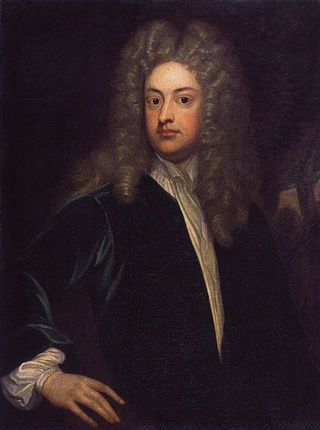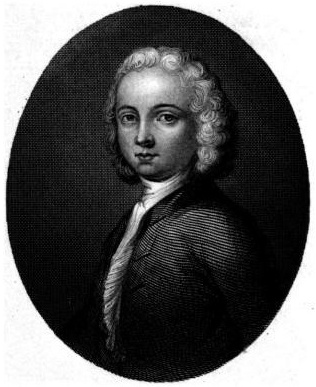Related Research Articles

Kubla Khan: or A Vision in a Dream is a poem written by Samuel Taylor Coleridge, completed in 1797 and published in 1816. It is sometimes given the subtitles "A Vision in a Dream" and "A Fragment." According to Coleridge's preface to Kubla Khan, the poem was composed one night after he experienced an opium-influenced dream after reading a work describing Shangdu, the summer capital of the Mongol-led Yuan dynasty of China founded by Kublai Khan. Upon waking, he set about writing lines of poetry that came to him from the dream until he was interrupted by "a person on business from Porlock". The poem could not be completed according to its original 200–300 line plan as the interruption caused him to forget the lines. He left it unpublished and kept it for private readings for his friends until 1816 when, at the prompting of Lord Byron, it was published.

Alexander Pope was an English poet, translator, and satirist of the Enlightenment era who is considered one of the most prominent English poets of the early 18th century. An exponent of Augustan literature, Pope is best known for his satirical and discursive poetry including The Rape of the Lock, The Dunciad, and An Essay on Criticism, and for his translations of Homer.

Joseph Addison was an English essayist, poet, playwright, and politician. He was the eldest son of Lancelot Addison. His name is usually remembered alongside that of his long-standing friend Richard Steele, with whom he founded The Spectator magazine. His simple prose style marked the end of the mannerisms and conventional classical images of the 17th century.

William Collins was an English poet. Second in influence only to Thomas Gray, he was an important poet of the middle decades of the 18th century. His lyrical odes mark a progression from the Augustan poetry of Alexander Pope's generation and towards the imaginative ideal of the Romantic era.

Robert Dodsley was an English bookseller, publisher, poet, playwright, and miscellaneous writer.

Mark Akenside was an English poet and physician.
This article contains information about the literary events and publications of 1744.

"Ode to a Nightingale" is a poem by John Keats written either in the garden of the Spaniards Inn, Hampstead, London or, according to Keats' friend Charles Armitage Brown, under a plum tree in the garden of Keats' house at Wentworth Place, also in Hampstead. According to Brown, a nightingale had built its nest near the house that he shared with Keats in the spring of 1819. Inspired by the bird's song, Keats composed the poem in one day. It soon became one of his 1819 odes and was first published in Annals of the Fine Arts the following July. The poem is one of the most frequently anthologized in the English language.

Thomas Tickell was a minor English poet and man of letters.

In aesthetics, the sublime is the quality of greatness, whether physical, moral, intellectual, metaphysical, aesthetic, spiritual, or artistic. The term especially refers to a greatness beyond all possibility of calculation, measurement, or imitation.
The "Graveyard Poets", also termed "Churchyard Poets", were a number of pre-Romantic poets of the 18th century characterised by their gloomy meditations on mortality, "skulls and coffins, epitaphs and worms" elicited by the presence of the graveyard. Moving beyond the elegy lamenting a single death, their purpose was rarely sensationalist. As the century progressed, "graveyard" poetry increasingly expressed a feeling for the "sublime" and uncanny, and an antiquarian interest in ancient English poetic forms and folk poetry. The "graveyard poets" are often recognized as precursors of the Gothic literary genre, as well as the Romantic movement.

The Spectator was a daily publication founded by Joseph Addison and Richard Steele in England, lasting from 1711 to 1712. Each "paper", or "number", was approximately 2,500 words long, and the original run consisted of 555 numbers, beginning on 1 March 1711. These were collected into seven volumes. The paper was revived without the involvement of Steele in 1714, appearing thrice weekly for six months, and these papers when collected formed the eighth volume. Eustace Budgell, a cousin of Addison's, and the poet John Hughes also contributed to the publication.

The Spectre is one aspect of the fourfold nature of the human psyche along with Humanity, Emanation and Shadow that William Blake used to explore his spiritual mythology throughout his poetry and art. As one of Blake's elements of the psyche, Spectre takes on symbolic meaning when referred to throughout his poems. According to professor Joseph Hogan, "Spectre functions to define individuals from others [...] When it is separated [from Emanation], it is reason, trying to define everything in terms of unchanging essences." Thus, according to Samuel Foster Damon, Spectre epitomizes "Reason separated from humanity" and "Self-centered selfhood" or, as Alexander S. Gourlay puts it, Spectre is "characterized by self-defensive rationalization".
Nationality words link to articles with information on the nation's poetry or literature.
Nationality words link to articles with information on the nation's poetry or literature.

Nationality words link to articles with information on the nation's poetry or literature.
Nationality words link to articles with information on the nation's poetry or literature.
Stephen Duck was an English poet whose career reflected both Augustan interest in "naturals" and its resistance to classlessness.

The Female Spectator, published by Eliza Haywood between 1744 and 1746, is generally considered to be the first periodical in English written by women for women.

Rosamond is an opera in three acts by Thomas Clayton with a libretto by Joseph Addison. It was first performed on 4 March 1707 at Drury Lane.
References
- ↑ Hart, Jeffrey (1959). "Akenside's Revision of the Pleasures of Imagination". PMLA. 74 (1). JSTOR: 67–74. doi:10.2307/460387. JSTOR 460387. S2CID 163320052.
- ↑ Sanyal, Lopa (2006). English Literature in Eighteenth Century. New Delhi: Discovery Publishing House. p. 232. ISBN 978-8183561365 . Retrieved 22 January 2019.
- ↑ "Joseph Addison (1672-1719)". Minnesota State University. Retrieved 22 January 2019.